Balkinization
an unanticipated consequence of
Jack M. Balkin
Balkinization Symposiums: A Continuing List
E-mail:
Jack Balkin:
jackbalkin at yahoo.com
Bruce Ackerman
bruce.ackerman at yale.edu
Ian Ayres
ian.ayres at yale.edu
Corey Brettschneider
corey_brettschneider at brown.edu
Mary Dudziak
mary.l.dudziak at emory.edu
Joey Fishkin
joey.fishkin at gmail.com
Heather Gerken heather.gerken at yale.edu
Abbe Gluck abbe.gluck at yale.edu
Mark Graber
mgraber at law.umaryland.edu
Stephen Griffin
sgriffin at tulane.edu
Jonathan Hafetz
jonathan.hafetz at shu.edu
Jeremy Kessler
jkessler at law.columbia.edu
Andrew Koppelman
akoppelman at law.northwestern.edu
Marty Lederman
msl46 at law.georgetown.edu
Sanford Levinson
slevinson at law.utexas.edu
David Luban
david.luban at gmail.com
Gerard Magliocca
gmaglioc at iupui.edu
Jason Mazzone
mazzonej at illinois.edu
Linda McClain
lmcclain at bu.edu
John Mikhail
mikhail at law.georgetown.edu
Frank Pasquale
pasquale.frank at gmail.com
Nate Persily
npersily at gmail.com
Michael Stokes Paulsen
michaelstokespaulsen at gmail.com
Deborah Pearlstein
dpearlst at yu.edu
Rick Pildes
rick.pildes at nyu.edu
David Pozen
dpozen at law.columbia.edu
Richard Primus
raprimus at umich.edu
K. Sabeel Rahmansabeel.rahman at brooklaw.edu
Alice Ristroph
alice.ristroph at shu.edu
Neil Siegel
siegel at law.duke.edu
David Super
david.super at law.georgetown.edu
Brian Tamanaha
btamanaha at wulaw.wustl.edu
Nelson Tebbe
nelson.tebbe at brooklaw.edu
Mark Tushnet
mtushnet at law.harvard.edu
Adam Winkler
winkler at ucla.edu
Compendium of posts on Hobby Lobby and related cases
The Anti-Torture Memos: Balkinization Posts on Torture, Interrogation, Detention, War Powers, and OLC
The Anti-Torture Memos (arranged by topic)
Recent Posts
A Perpetual Monopoly
Just A Few Blogs
ACS Blog
Alas, a Blog
Althouse
Arts and Letters Daily
Atrios (Eschaton)
Bill of Health
Buzzflash.com
Buzz Machine
Cato at Liberty
Juan Cole (Informed Comment)
Concurring Opinions
The Constitution in 2020
Corrente
Crooked Timber
Daily Howler
Daily Kos
Dana Boyd
Brad DeLong
Digby (Hullabaloo)
Discriminations
Daniel Drezner
Kevin Drum (Mother Jones)
Electrolite
En Banc
Eunomia (Daniel Larison)
Fafblog
Michael Froomkin (Discourse.net)
GovLab (Beth Noveck)
Rick Hasen (Election Law)
History News Network
How Appealing
Ignatz (Sam Heldman)
The Importance of (Ernie Miller)
Infolaw
Instapundit
International Economic Law and Policy Blog
IntLawGrrls
Jacob Levy
Jesus' General
Jurisdynamics
The Kitchen Cabinet
Mark Kleiman
Law Blog Central
Larry Lessig
Lawyers, Guns and Money
Liberal Oasis
Brian Leiter's Law School Reports
The Leiter Reports
Marginal Revolution
Megan McArdle
Memeorandum
Metafilter
Mirror of Justice
The New Republic
Newseum
No More Mister Nice Blog
Brendan Nyhan
Opinio Juris
Orcinus
The Originalism Blog
Pandagon
Passport (Foreign Policy)
Overcoming Bias
Political Animal (Washington Monthly)
Political Theory Daily Review
Political Wire (Taegan Goddard)
The Poor Man
Virginia Postrel
Prawfsblawg
Public Reason
Jonathan Rauch
Raw Story
Redstate
ReligiousLeftLaw.com
Reporters Committee For Freedom of the Press
Reproductive Rights Blog
Rothman's Roadmap to the Right of Publicity
SCOTUS Blog
Seeing the Forest
Clay Shirky
The Shifted Librarian
The Situationist
Larry Solum (Legal Theory)
Andrew Sullivan
Talking Points Memo
Talk Left
Tapped
Tbogg
TechPresident
The Paper Chase (Jurist)
Tom Paine
Tom Tomorrow (This Modern World)
Eve Tushnet
Uggabugga
University of Chicago Law School Faculty Blog
Unqualified Offerings
The Volokh Conspiracy
War and Piece (Laura Rozen)
Wampum
Oliver Willis
Wonkette
Written Description
Matthew Yglesias
Yin
Your Choice of Feeds
1. XML
powered by
2. Atom Feed
3. RSS 2.0
A Perpetual Monopoly
Guest Blogger
For the Balkinization symposium on Robert Post, The Taft Court: Making Law for a Divided Nation, 1921–1930 (Cambridge University Press, 2024). Jill Lepore In May 1923, weeks after the U.S. Supreme Court handed down
its decision in Adkins v. Children’s
Hospital, the nation’s leading labor reformer, the lawyer Florence Kelley, called
for an overhaul of the federal judiciary. She wanted to put women on the bench.[1] In Adkins, the
Court struck down DC’s minimum wage law for women. Justice George Sutherland,
writing for the majority, argued that labor laws aimed at women amounted to an
unconstitutional interference in the liberty of contract and that, in any case,
such laws were no longer necessary because the “ancient inequality of the
sexes” had become, by the dizzying, Model Ts-and-frozen-food age of the flapper,
a thing of the past. Given “the great -- not to say
revolutionary -- changes … in the contractual, political and civil status of
women, culminating in the Nineteenth Amendment,” Sutherland wrote, “it is not
unreasonable to say that these differences have now come almost, if not quite,
to the vanishing point.”[2] (Oliver Wendell Holmes notably dissented: “It will need more
than the Nineteenth Amendment to convince me that there are no differences
between men and women, or that legislation cannot take those differences into
account.”) Florence Kelley didn’t think you had to squint to notice the enduringly
unequal status of women in the United States in 1923. You could, for instance, turn
your gaze on the court itself, and give it one long, hard stare. Sutherland was celebrating--and, sadly,
wildly overstating--changes he’d had a real hand in, as had his wife, Rosamond
Lee Sutherland. From the time of Sutherland’s election to Congress from Utah in
1900 and through his years in the Senate, he and she had fought for woman
suffrage, hosting delegations at their home in Washington, making speeches at
suffrage meetings, and publishing articles in magazines. In 1913 when suffragists
“stormed the Capitol to argue why women should have the ballot,” according to
the Salt Lake Telegram, Rosamond Lee
Sutherland was one two senators’ wives to join the delegation; the other was the
formidable feminist lawyer Belle Case LaFollette, wife of Wisconsin Senator
Robert LaFollette.[3]
The next year, George Sutherland, speaking in the Senate, denounced the rule of
women by men: “To deprive... [women] of the right to participate in government
is to make an arbitrary division of the citizenship of the country upon the
sole ground that one class is made up of men, and should therefore rule, and
the other class is made up of women, who should, therefore, be ruled.”[4]
In 1915, he introduced the Nineteenth Amendment into the
Senate and declared women’s disenfranchisement “an unjust and intolerant denial
of equality.”[5] In 1923, Sutherland was working with Alice Paul, head of the
National Woman’s Party, on a draft of the Equal Rights Amendment, even as he
was writing his opinion in Adkins.[6] Adkins is today mainly
remembered for setting in (very slow) motion the confrontation between FDR and
the Court over the New Deal. Robert C. Post, in his magisterial and richly
illuminating study of the Taft Court, reads the case as having “decisively set
the Taft Court on the path toward normalcy,” after its tolerance of emergency war
measures that included price- and wage-setting and all manner of wartime
control of the economy. (I’ve published a review of the book elsewhere.)
Taft, who had headed the War Labor Board, and found it hard to dismiss,
outright, the need for a wage floor, dissented, but this would be his last real
disagreement with his court’s conservative majority. “In the course of the
decade,” Post writes, “Adkins would
flower into a line of cases prohibiting price fixing that would set the Court
on a collision course with the New Deal, and Taft would be solidly in the
majority.”[7]
When that collision came, Adkins would
be reversed, in West Coast Hotel Company
v. Parrish (1937), in which the Court upheld a Washington state minimum
wage law for women. An aging Sutherland, still on the bench, dissented, accusing
the majority of effectively amending the Constitution. “The judicial function
is that of interpretation; it does not include the power of amendment under the
guise of interpretation,” he scolded them.[8] That’s how lawyers tend to think about Adkins, reading it backwards from West Coast Hotel, and thinking about the Fourteenth Amendment. Historians,
reading the case forward from the Nineteenth Amendment, are more likely to
remember Adkins as marking a fork in
the road between Alice Paul and Florence Kelley. “The litigation that
culminated in the Adkins decision
altered the course of social reform, recast women’s claims to constitutional
rights, and propelled Kelley and Paul toward different, incompatible kinds of
arguments,” as Joan Zimmerman long ago argued in a particularly incisive
article in the Journal of American
History.[9] No case’s outcome is foreordained,
which is why it’s distorting to read Adkins
by way of West Coast Hotel, and more
sensible to read it as the aftermath of the Nineteenth Amendment. One way to
glimpse the contingency of these events—to restore the sense of how differently
things might have turned out--is to consider the close alignment between the
views of Florence Kelley and those of Justice Sutherland’s wife. In 1910,
Rosamond Lee Sutherland published an essay called “The Appeal of
Politics to Woman,” in the North American
Review. In it, she argued that women needed more than the right to vote:
they needed to be elected and appointed to public offices because laws made,
enforced, and interpreted by men will be unfair to women and children. “Are
there not many ways in which the active voice, as well as the passive influence
of women, is sadly needed in remedial legislation to-day?” she asked. “Does not
the cause of working women need serious attention?” For instance, there was the
problem of unfair wages for women. “Men and women work shoulder to shoulder as
teachers, clerks and in countless capacities as wage-earners, but the men
almost invariably receive much better salaries, not because they do better work
or are more trustworthy, but simply because they are men; which is unjust,
illogical and all wrong.” Then, too, she wrote, “the crying evil of child labor
would surely be eradicated were women instrumental in making and enforcing the
laws.”[10] The person in the United States heading the effort to
eradicate each of these crying evils was Florence Kelley, who led not only the
campaign for maximum-hour and minimum-wage laws for women but also the urgent
and exhausting campaign to end child labor. The obstacle to all of that work
was the U.S. Supreme Court. In 1918, in Hammer v. Dagenhart, the Court struck down a federal child labor law and
in 1922 in Bailey v. Drexel Furniture Co., it overturned the
Child Labor Tax Law. Then came Adkins. Kelley called it “a new Dred
Scott.”[11] “Three times in three years the Supreme Court has given
warning that justice and mercy for women and children are not to be expected
from a court which, itself a perpetual monopoly of men, incarnates age-long
injustice,” wrote Kelley in that commentary published weeks after Sutherland
issued the Court’s decision.[12]
Where Sutherland had insisted that the “ancient inequality of the sexes” had
been all but eradicated by the Nineteenth Amendment, Kelley answered that the
Court itself represented an “age-long injustice” in the form of the “perpetual
monopoly of men” serving on the bench. To break that monopoly, the next
appointees to both the Supreme Court and the DC Court of Appeals, Kelley
insisted, had to be female, “the first in a series of women.”[13] That was one idea. Devastated and not a little desperate after Adkins,
Progressives proposed all manner of reforms to the Court. Robert
LaFollette, denouncing the Court’s child labor rulings as “judicial oligarchy,”
proposed a constitutional amendment granting states the right to nullify
opinions of the Court.[14]
An Arizona congressman introduced a constitutional amendment requiring a
seven-justice majority for any law to be declared unconstitutional (a proposal
Kelley supported).[15]
Idaho Senator William Borah proposed legislation to that end. Washington
senator Clarence Dill suggested the justices serve for non-renewable six-year
terms.[16]
Three state governors called for a meeting of governors to frame a
constitutional amendment granting Congress the power to set a minimum wage.[17]
Restrain the Court; amend the Constitution. And that pretty much gets us to the
bottom of the bucket of solutions. The Court was indeed reformed in the 1920s, just not along
the lines any of these people proposed. Taft joined the Court in 1921 and the
next year presented to the House Judiciary Committee legislation that he and a
committee of justices had drafted, known as the Judges Bill. Its most important
element was the certiorari process which, Taft, said, would allow the justices
to “decide what was important and what was unimportant.”[18]
The Judges Bill rationalized all manner of procedures within the federal
judiciary. It also gave the Court much more power, not less. (Brandeis, for
instance, opposed it.) Congress passed the plan in 1925, a date that happened
to fall midway through Taft’s tenure—he resigned in 1930, suffering from
dementia, one month before his death. Taft wanted to make the Court more
efficient; Kelley wanted to make it more representative. Set the nine men on
the bench aside, two bowties, one cravat, six neckties. Forget the New Deal,
which hadn’t happened yet. Wasn’t this a case about women? That was another
of Kelley’s points. It still holds. “Although the life, health and happiness of
women and girls are at stake, no woman has participated in the minimum wage
case at any of its stages,” Kelley pointed out in her reading of Sutherland’s
opinion. This wasn’t strictly accurate. No female lawmakers had voted on the DC
law, no female judge or justice had heard the case, no female lawyers had
argued it. But Kelley had a hand in writing a great many of the nation’s labor
laws, including DC’s minimum wage law for women, on which she’d collaborated
with Felix Frankfurter, who then went on to argue for the appellants in Adkins.[19]
And Molly Dewson, Kelley’s deputy, had drafted much of the 1248-page brief for
the DC minimum wage board in Adkins, even
though it went out under Frankfurter’s name.[20]
Still, in the end, Sutherland decided to ignore Dewson’s work in its entirety,
declaring the empirical evidence in her brief—more than a thousand pages of
statistics, testimony, and analysis regarding the suffering of women--as having
shed “no legitimate light on the question.”[21] When Frankfurter read the Court’s opinion, he telegrammed
Kelley: “Upshot would be adoption of Alice Paul theory of constitutional law.”[22]
The Alice Paul theory of constitutional law is a theory Florence Kelley
considered a species of insanity. As soon as the Nineteenth Amendment was
ratified, Paul had begun crafting a new constitutional amendment. “There is at
this moment an insanity prevalent among women where one would least expect it,”
Kelley wrote about an early draft of the Equal Rights Amendment. “The slogans
of the insane are ‘A fair field and no favor,--Equal rights for women, nothing
more.—We ask no privileges now that we have the vote.”[23]
As for the very term—equality, Kelley had little use for it. “Let’s not begin
with meaningless words,” she’d once said. ‘Equality’ where there is no equality
is a terrible a thing for the defenseless workers as the cry of ‘peace’ where
there is no peace.” She felt the same way about “liberty of contract.”[24] Alice Paul had struggled over the question of whether a
prohibition on discrimination by sex would undermine labor legislation. She’d sent
drafts of the Equal Rights Amendment to Sutherland—one draft’s Section 2 read,
“This article shall not be interpreted as preventing legislation in the
exercise of the police power or for the protection of women in industry”—but
after Sutherland and other lawyers she consulted took the position that the
clause was not needed, it was deleted.[25]
She’d then aided the plaintiffs in Atkins
and, by the end of the year, had succeeded in having the Equal Rights
Amendment, introduced into Congress. Lost in the tug-of-war between Kelley and Paul was their
shared understanding that the Constitution was not written for women and
children, that neither the Court nor any other institution that excludes women
can be counted on to remedy so dire an inadequacy. After Adkins, Florence Kelley turned her attention to drafting and
lobbying for the Child Labor Amendment.[26]
Paul’s amendment aimed to eliminate a distinction; Kelley’s aimed to make one. The
CLA passed Congress in 1924, the ERA in 1972. Neither was ever ratified.
They’re two of only six constitutional amendments to have gone to the states
and failed. The divide between Kelley and Paul impeded
both Progressive labor legislation and the movement for equality under the law.
It also contributed to the Court’s abandonment of the Nineteenth Amendment. After
Adkins, the Nineteenth Amendment
hardly ever again made an appearance in a Supreme Court opinion even though
there was every reason, at the time, to expect that it would mark the beginning
of a rich vein of meaning-making. University of Maryland law professor Paula
A. Monopoli has argued in her 2020 book, Constitutional
Orphan, that the aftermath of Adkins
is itself is responsible for the creation of “a vacuum around the Nineteenth
Amendment.” Followers of Kelley shied away from arguments
invoking the Nineteenth Amendment’s implications for equality lest it be used,
again, to undermine labor legislation, and followers of Paul pivoted to the
Equal Rights Amendment, leaving constitutional thinking around the Nineteenth
Amendment undeveloped.[27] There is no Nineteenth Amendment
Doctrine. But that’s not only because of what divided women after Adkins. It’s also because the Court was
fundamentally uninterested in the Nineteenth Amendment. The Taft Court is the last of the originally planned volumes of the
Oliver Wendell Holmes Devise History of the Supreme Court of the United States.
Whatever history scholars write, the Court tells its own history in the
opinions it generates. It erases whatever it wishes, which, as it happens,
includes anything and everything ever written by a woman. “Those who
sought votes for women made claims for liberty and equality in the family on
which constitutional law might now draw—but there is no trace of their voices
or claims in constitutional law,” Reva Siegel argued in her searing 2022 essay,
“The Politics of Constitutional Memory.” That includes Florence Kelley and
Alice Paul and dozens more whose names, as Siegel notes, appear nowhere in the United States Reports.[28]
And, as Monopoli noted in a 2023 article, “Situating Dobbs,” “The majority opinion in Dobbs is essentially devoid of
women as legal authorities.”[29]
In Dobbs, women never appear as
thinkers; they appear only as body parts. You don’t have to squint to notice
the enduringly unequal status of women in the United States in 1924. Florence
Kelley wanted to put women on the bench. A century later, a lot of people would
like the Court to put women in its opinions. The Dobbs majority’s failure to engage with, to cite, or even to
display any knowledge of the existence of constitutional writing by women is
bizarre, not least because by no means does this writing fall to one side of any
constitutional question, as the history of Adkins
illustrates. Women don’t agree with one another anymore than men do, and never
have. “The perpetual monopoly of men” that Kelley denounced wasn’t and isn’t
about dismissing the ideas of women on the basis of disagreement with them; it
was and is about dismissing the possibility that women have ideas. In the Court’s
understanding of its own history, this notion not only still prevails but also
structures its reasoning and shatters its authority. Jill Lepore is David Woods Kemper '41 Professor of American History, Harvard College Professor, and Affiliate Professor of Law at Harvard University. You can reach her by e-mail at jlepore@fas.harvard.edu.
[1] Florence Kelley, “Women on the
Bench,” The Survey, May 15, 1923.
Available at https://archive.org/details/surveycharityorg50survrich/page/220/mode/2up [2] Adkins v. Children’s Hospital (1923). [3] “Suffragists Again Argue for
Ballot,” Salt Lake Telegram, April
26, 1913. https://newspapers.lib.utah.edu/search?facet_type=%22page%22&gallery=1&rows=200&parent_i=18938083#g0 [4] Samuel R. Olken, “Justice
Sutherland Reconsidered,” Vanderbilt Law
Review 639 (2019): 62-639-693. [5] https://amendmentsproject.org/search?view=None&search_any_field=&summary=&amendment_text=&type=&date_before=&date_after=&sponsor=263f26f6-bb71-4991-89d2-d2cacba6535b&sort=relevance&size=25&page=1 [6] For recent reassessments of
Sutherland and for more on his suffragism, see Samuel R. Olken, “Justice
Sutherland Reconsidered,” Vanderbilt Law
Review 639 (2019): 62-639-693, and David E. Bernstein, “Revisiting Justice
George Sutherland, the Nineteenth Amendment, and Equal Rights for Women,” Georgetown Journal of Law and Public Policy 20
(2022): 143-161 [7] Post, The Taft Court, 2:755, 766. [8] West Coast Hotel Company v. Parrish (1937), Sutherland, dissenting. [9] Joan Zimmerman, “The
Jurisprudence of Equality: The Women’s Minimum Wage, the First Equal Rights
Amendment, and Adkins v. Children’s
Hospital, 1905-1923,” The Journal of
American History (1991): 188-225. For more on Kelley and this moment, see,
e.g., Sybil Lipschultz, “Social Feminism and Legal Discourse: 1908-1923,” Yale Journal of Law and Feminism 2
(1989): 131-160. [10] Rosamond Lee Sutherland, “The
Appeal of Politics to Woman,” North
American Review 191 (1910): 75-86. [11] Quoted in Paula A. Monopoli,
“Situating Dobbs,” ConLawNOW 14 (2023): 45-63. [12] Florence Kelley, “Women on the
Bench,” The Survey, May 15, 1923.
Available at
https://archive.org/details/surveycharityorg50survrich/page/220/mode/2up [13] Florence Kelley, “Women on the
Bench,” The Survey, May 15, 1923.
Available at
https://archive.org/details/surveycharityorg50survrich/page/220/mode/2up [14] “Judicial Oligarchy Rules the
Nation, LaFollette Claims,” Austin
Statesman, June 14, 1922. [15]
https://amendmentsproject.org/amendments/b067-h00015/ [16]
https://amendmentsproject.org/amendments/bp_19230417sen-aa/ [17] Post, The Taft Court, 2:766. [18] Jonathan Sternberg, “Deciding
Not to Decide: The Judiciary Act of 1925 and the Discretionary Court,” Journal of Supreme Court History 33
(2008), 1-16, available at https://www.martindale.com/matter/asr-1628380.pdf [19] The standard biography remains
Kathryn Kish Sklar, Florence Kelley and
the Nation’s Work: The Rise of Women’s Political Culture, 1830-1900 (New
Haven: Yale University Press, 1995), but for an example of a more recent
assessment see Felice J. Batlan, “Florence Kelley and the Battle Against
Laissez-Faire Constitutionalism” (2010), available at
https://scholarship.kentlaw.iit.edu/cgi/viewcontent.cgi?article=1068&context=fac_schol. [20] District of Columbia minimum
wage cases; Brief for appellants ; Supreme Court of the United States, October
term, 1922. Available at https://curiosity.lib.harvard.edu/women-working-1800-1930/catalog/45-990022823110203941 [21] And here see Post, The Taft Court, 2: 760. [22] Quoted in Zimmerman, “The
Jurisprudence of Equality,” 222. [23] Quoted in Zimmerman, “The
Jurisprudence of Equality,” 207. [24] Paula A. Monopoli, “Situating Dobbs,” ConLawNOW 14 (2023): 45-63. [25] Zimmerman, “The Jurisprudence of
Equality,” 213. [26] Felice J. Batlan, “Florence
Kelley and the Battle Against Laissez-Faire Constitutionalism” (2010),
available at
https://scholarship.kentlaw.iit.edu/cgi/viewcontent.cgi?article=1068&context=fac_schol. [27] Paula A. Monopoli, “Defining
Equality,” in Constitutional Orphan:
Gender Equality and the Nineteenth Amendment (New York: Oxford University
Press, 2020), chapter 7. [28] Reva Siegel, “The Politics of
Constitutional Memory,” Georgetown
Journal of Law and Public Policy 20 (2022): 19-58. [29] Paula A. Monopoli, “Situating Dobbs,” ConLawNOW 14 (2023): 45-63.
Posted
9:30 AM
by Guest Blogger [link]
Books by Balkinization Bloggers

Linda C. McClain and Aziza Ahmed, The Routledge Companion to Gender and COVID-19 (Routledge, 2024)

David Pozen, The Constitution of the War on Drugs (Oxford University Press, 2024)

Jack M. Balkin, Memory and Authority: The Uses of History in Constitutional Interpretation (Yale University Press, 2024)
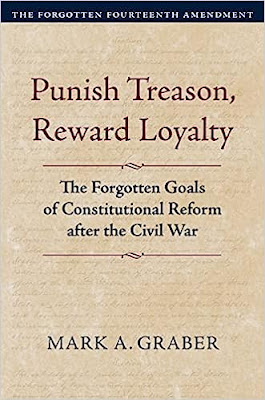
Mark A. Graber, Punish Treason, Reward Loyalty: The Forgotten Goals of Constitutional Reform after the Civil War (University of Kansas Press, 2023)
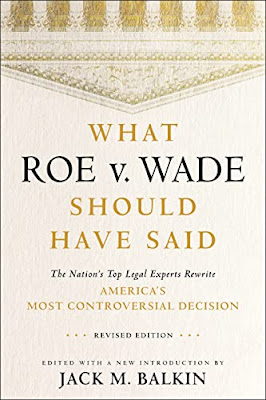
Jack M. Balkin, What Roe v. Wade Should Have Said: The Nation's Top Legal Experts Rewrite America's Most Controversial Decision - Revised Edition (NYU Press, 2023)

Andrew Koppelman, Burning Down the House: How Libertarian Philosophy Was Corrupted by Delusion and Greed (St. Martin’s Press, 2022)

Gerard N. Magliocca, Washington's Heir: The Life of Justice Bushrod Washington (Oxford University Press, 2022)
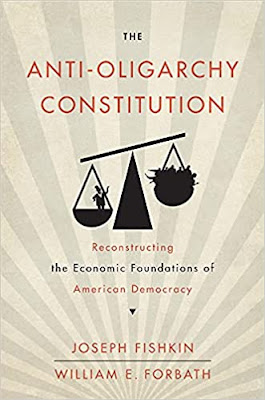
Joseph Fishkin and William E. Forbath, The Anti-Oligarchy Constitution: Reconstructing the Economic Foundations of American Democracy (Harvard University Press, 2022)
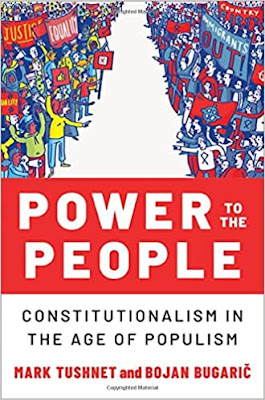
Mark Tushnet and Bojan Bugaric, Power to the People: Constitutionalism in the Age of Populism (Oxford University Press 2021).

Mark Philip Bradley and Mary L. Dudziak, eds., Making the Forever War: Marilyn B. Young on the Culture and Politics of American Militarism Culture and Politics in the Cold War and Beyond (University of Massachusetts Press, 2021).

Jack M. Balkin, What Obergefell v. Hodges Should Have Said: The Nation's Top Legal Experts Rewrite America's Same-Sex Marriage Decision (Yale University Press, 2020)

Frank Pasquale, New Laws of Robotics: Defending Human Expertise in the Age of AI (Belknap Press, 2020)

Jack M. Balkin, The Cycles of Constitutional Time (Oxford University Press, 2020)

Mark Tushnet, Taking Back the Constitution: Activist Judges and the Next Age of American Law (Yale University Press 2020).

Andrew Koppelman, Gay Rights vs. Religious Liberty?: The Unnecessary Conflict (Oxford University Press, 2020)

Ezekiel J Emanuel and Abbe R. Gluck, The Trillion Dollar Revolution: How the Affordable Care Act Transformed Politics, Law, and Health Care in America (PublicAffairs, 2020)

Linda C. McClain, Who's the Bigot?: Learning from Conflicts over Marriage and Civil Rights Law (Oxford University Press, 2020)
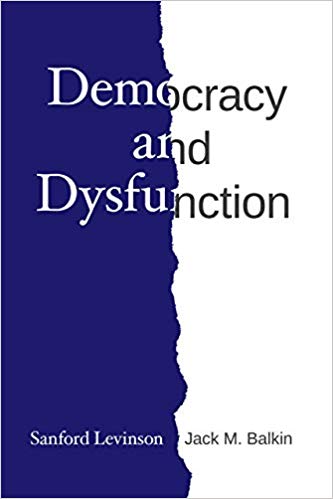
Sanford Levinson and Jack M. Balkin, Democracy and Dysfunction (University of Chicago Press, 2019)

Sanford Levinson, Written in Stone: Public Monuments in Changing Societies (Duke University Press 2018)

Mark A. Graber, Sanford Levinson, and Mark Tushnet, eds., Constitutional Democracy in Crisis? (Oxford University Press 2018)

Gerard Magliocca, The Heart of the Constitution: How the Bill of Rights became the Bill of Rights (Oxford University Press, 2018)

Cynthia Levinson and Sanford Levinson, Fault Lines in the Constitution: The Framers, Their Fights, and the Flaws that Affect Us Today (Peachtree Publishers, 2017)

Brian Z. Tamanaha, A Realistic Theory of Law (Cambridge University Press 2017)

Sanford Levinson, Nullification and Secession in Modern Constitutional Thought (University Press of Kansas 2016)

Sanford Levinson, An Argument Open to All: Reading The Federalist in the 21st Century (Yale University Press 2015)

Stephen M. Griffin, Broken Trust: Dysfunctional Government and Constitutional Reform (University Press of Kansas, 2015)

Frank Pasquale, The Black Box Society: The Secret Algorithms That Control Money and Information (Harvard University Press, 2015)

Bruce Ackerman, We the People, Volume 3: The Civil Rights Revolution (Harvard University Press, 2014)
Balkinization Symposium on We the People, Volume 3: The Civil Rights Revolution

Joseph Fishkin, Bottlenecks: A New Theory of Equal Opportunity (Oxford University Press, 2014)

Mark A. Graber, A New Introduction to American Constitutionalism (Oxford University Press, 2013)

John Mikhail, Elements of Moral Cognition: Rawls' Linguistic Analogy and the Cognitive Science of Moral and Legal Judgment (Cambridge University Press, 2013)

Gerard N. Magliocca, American Founding Son: John Bingham and the Invention of the Fourteenth Amendment (New York University Press, 2013)

Stephen M. Griffin, Long Wars and the Constitution (Harvard University Press, 2013)

Andrew Koppelman, The Tough Luck Constitution and the Assault on Health Care Reform (Oxford University Press, 2013)

James E. Fleming and Linda C. McClain, Ordered Liberty: Rights, Responsibilities, and Virtues (Harvard University Press, 2013)
Balkinization Symposium on Ordered Liberty: Rights, Responsibilities, and Virtues

Andrew Koppelman, Defending American Religious Neutrality (Harvard University Press, 2013)

Brian Z. Tamanaha, Failing Law Schools (University of Chicago Press, 2012)

Sanford Levinson, Framed: America's 51 Constitutions and the Crisis of Governance (Oxford University Press, 2012)

Linda C. McClain and Joanna L. Grossman, Gender Equality: Dimensions of Women's Equal Citizenship (Cambridge University Press, 2012)

Mary Dudziak, War Time: An Idea, Its History, Its Consequences (Oxford University Press, 2012)

Jack M. Balkin, Living Originalism (Harvard University Press, 2011)

Jason Mazzone, Copyfraud and Other Abuses of Intellectual Property Law (Stanford University Press, 2011)

Richard W. Garnett and Andrew Koppelman, First Amendment Stories, (Foundation Press 2011)

Jack M. Balkin, Constitutional Redemption: Political Faith in an Unjust World (Harvard University Press, 2011)

Gerard Magliocca, The Tragedy of William Jennings Bryan: Constitutional Law and the Politics of Backlash (Yale University Press, 2011)

Bernard Harcourt, The Illusion of Free Markets: Punishment and the Myth of Natural Order (Harvard University Press, 2010)

Bruce Ackerman, The Decline and Fall of the American Republic (Harvard University Press, 2010)
Balkinization Symposium on The Decline and Fall of the American Republic

Ian Ayres. Carrots and Sticks: Unlock the Power of Incentives to Get Things Done (Bantam Books, 2010)

Mark Tushnet, Why the Constitution Matters (Yale University Press 2010)
Ian Ayres and Barry Nalebuff: Lifecycle Investing: A New, Safe, and Audacious Way to Improve the Performance of Your Retirement Portfolio (Basic Books, 2010)
.jpg)
Jack M. Balkin, The Laws of Change: I Ching and the Philosophy of Life (2d Edition, Sybil Creek Press 2009)

Brian Z. Tamanaha, Beyond the Formalist-Realist Divide: The Role of Politics in Judging (Princeton University Press 2009)
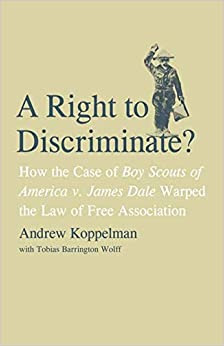
Andrew Koppelman and Tobias Barrington Wolff, A Right to Discriminate?: How the Case of Boy Scouts of America v. James Dale Warped the Law of Free Association (Yale University Press 2009)

Jack M. Balkin and Reva B. Siegel, The Constitution in 2020 (Oxford University Press 2009)
Heather K. Gerken, The Democracy Index: Why Our Election System Is Failing and How to Fix It (Princeton University Press 2009)

Mary Dudziak, Exporting American Dreams: Thurgood Marshall's African Journey (Oxford University Press 2008)

David Luban, Legal Ethics and Human Dignity (Cambridge Univ. Press 2007)

Ian Ayres, Super Crunchers: Why Thinking-By-Numbers is the New Way to be Smart (Bantam 2007)

Jack M. Balkin, James Grimmelmann, Eddan Katz, Nimrod Kozlovski, Shlomit Wagman and Tal Zarsky, eds., Cybercrime: Digital Cops in a Networked Environment (N.Y.U. Press 2007)
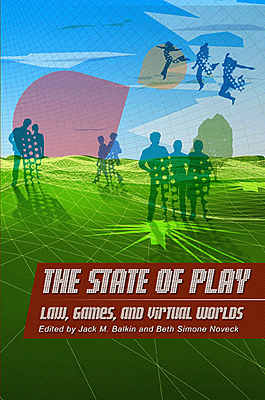
Jack M. Balkin and Beth Simone Noveck, The State of Play: Law, Games, and Virtual Worlds (N.Y.U. Press 2006)

Andrew Koppelman, Same Sex, Different States: When Same-Sex Marriages Cross State Lines (Yale University Press 2006)
Brian Tamanaha, Law as a Means to an End (Cambridge University Press 2006)
Sanford Levinson, Our Undemocratic Constitution (Oxford University Press 2006)
Mark Graber, Dred Scott and the Problem of Constitutional Evil (Cambridge University Press 2006)
Jack M. Balkin, ed., What Roe v. Wade Should Have Said (N.Y.U. Press 2005)
Sanford Levinson, ed., Torture: A Collection (Oxford University Press 2004)
Balkin.com homepage
Bibliography
Conlaw.net
Cultural Software
Writings
Opeds
The Information Society Project
BrownvBoard.com
Useful Links
Syllabi and Exams